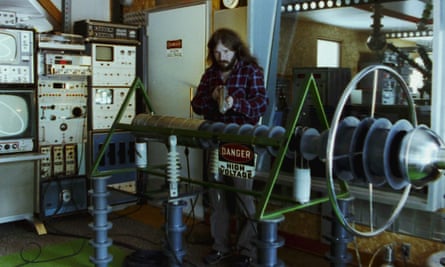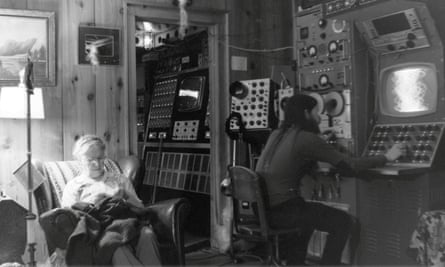A new documentary follows the 30-year cosmic quest by US space enthusiast John Shepherd. What drove him to beam messages and music, from Can to Coltrane, into space?

In the mid-1960s, when he was a boy living in rural Michigan, John Shepherd began thinking of ways to make contact with alien life forms. “It was round about the time that a show called The Outer Limits was on television,” he recalls. “I remember being fascinated by the idea of somehow building my own scientific instruments to explore the mysterious phenomenon that is extraterrestrial life.”
In 1972, from the living room of his grandparent’s house, he began chasing his dream by broadcasting a series of electronic tone pulses “towards the stars”. So began an extraordinary 30-year journey he called Project STRAT (Special Telemetry Research and Tracking). It would soon take over his life, and the lives of his grandparents, who found themselves living amid an expanding array of what he calls “beautiful and unusual instruments”, including dual-channel oscillators, cathode-ray tubes, giant screens to monitor incoming signals and a low frequency transmitter sending signals millions of miles into deep space.
Though he had little money, he trawled military surplus sales and a wholesale electrical warehouse in nearby Traverse City, collecting the materials he needed. In the garden, he erected “a two-storey 150,000 volt output stage” mounted on a pair of tall metal towers made from salvage that included a dismantled ski-lift. In the living room, scientific equipment was arranged, floor to ceiling, along one wall.
“Often, people passing by at night in their cars would see a bank of lights blinking in the living room and they’d pull over to stop and stare,” he says. “Maybe they had been watching The Outer Limits, too, and they were wondering what was going on. I remember some people even thought we had built a Russian spy system.”

Last Thursday, Netflix premiered an intriguing short film called John Was Trying to Contact Aliens, which earlier this year won the prize for best documentary short at the Sundance festival. Shot, edited and directed by Matthew Killip, son of the revered British documentary photographer, Chris Killip, it distils Shepherd’s 30-year quest into just 16 magical minutes.
“I wanted to tell his story economically and sparely, while keeping some of the mystery intact,” says Killip. “John is a wonderful subject but there is something mysterious and guarded about him that may stem from his troubled early life. I tried to balance that narrative with his extraordinary obsession, which lies somewhere between the realms of science and outsider art. The more I thought about what he did, the more it seemed like an elaborate 30-year art performance.”
In the 1970s, Shepherd’s obsession intermittently drew local reporters to his door. In 1989, he was even granted his 15 minutes of nationwide fame with an appearance on The Joan Rivers Show. On YouTube, you can see him, squeezed between two other ufologists, an intense young man with long hair and a beard, explaining his mission to his somewhat sceptical host, who points out that, after 16 years, the ETs have still not returned his calls.
By then, with the help of his grandmother Irene’s life savings, Shepherd had constructed a spacious two-story laboratory next to his grandparents’ house. “While my body was in the local community,” he tells Killip, “my mind was in space and in other realms, travelling the cosmos.” Flickering home-movie footage from that time reveals a futuristic interior filled with screens, consoles and arrays of beeping lights: the Starship Enterprise transposed to small-town Michigan.
Using a giant transmitter in the front garden, he began beaming music into space for several hours a day, from the likes of Sun Ra, Ornette Coleman and John Coltrane alongside German experimentalists such as Can, Cluster and Harmonia. At one point, we see the young Shepherd leaning intently into the microphone and announcing to the cosmos: “Now, we’re now going to bring you some Afro-pop to warm up your evening.”
Killip first became aware of Shepherd when he was perusing a book about UFO cults and saw a photograph of “a long-haired young man surrounded by banks of machinery with his grandma sitting beside him, knitting”. Between working at his day job as a film editor for the likes of artist Jeremy Deller, Killip had made a short film called Master of Reality about another American teenager outsider, Ronny Long, whose obsessions included wrestling and horror movies. “There were certain similarities in terms of their extreme single-mindedness,” he says.
In Killip’s tenderly observed portrait, Shepherd emerges as a sensitive soul, aware of his otherness and yet at one with it. The narrative touches briefly on his troubled early childhood – a father who left soon after he was born and an emotionally distant mother with whom he has had very little contact. “Things were rough in the early years,” he tells Killip, “My grandma felt sorry for me and took me with her.” At 12, Shepherd realised he was gay, which, he says in his inimitably understated way, proved “rather difficult” in rural Michigan in the early 1960s.
“I think if you have a troubled early life it does make for a more explorative journey,” he tells me matter-of-factly. “It certainly made me independent in a way and encouraged me to expand my horizons.”

“Most of what I did was self-taught, but my grandfather, who had worked as a toolmaker in Detroit, helped me with the often very precise practical stuff. It was my grandmother, though, who shared my interest in, how shall I put it, more exotic subjects. She definitely had a feeling for it and she brought a lot of inspiration into my life.” (Irene died in 1988 and the film is dedicated to her.)
In a moment of poignant self-reflection in the film, Shepherd compares his life’s journey to a trek along “a lonely mountain road”. That changed when he met his partner, John Litrenta, in 1993. They live, he says, “a quiet life on a lakefront house between two small towns”.
In 1998, due to lack of funds, Shepherd reluctantly dismantled his lab and put everything in storage, where it remains. He guides Killip through the jumbled space with a flashlight, pointing out his beloved machinery – satellite communication equipment, high-powered microwave tubes, a high-voltage transmitter accelerator. “These are just the remnants,” he says, “the leftover pieces of thought.”
“I miss it,” he tells me, “I really do, but I saved it all. It’s like a collection of beautiful objects. Waiting.”
In the film, he describes his long, strange creative endeavour as “a kind of dream state” that imbued his life with meaning. And, on the clip from the Rivers show, when she mentions his lack of success, he replies: “Like an artist can continue to paint even if he doesn’t sell his paintings, I can continue to build equipment and work on ideas.” Does he think, in retrospect, he was a conceptual artist as much as a scientist? “I guess so,” he says, quietly. “An artist of sound and light and electricity. And a maverick. Definitely a maverick. That would be a pretty good description.”
Sean O'Hagan
No comments:
Post a Comment
Note: Only a member of this blog may post a comment.